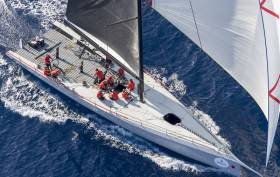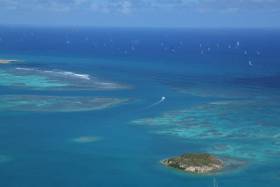Displaying items by tag: Howth Yacht Club
Bam Goes Well In Class, And Lee Overlay Starts To Shift
UPDATE 2200hrs: The RORC Caribbean 600 continues to be a race of swings and roundabouts as different boats come to the fore depending on which part of this multi-island course they’re sailing along writes W M Nixon. There are stages where the only encouragement is in maintaining your class position, and this Wednesday evening at 2200 hrs, Conor Fogerty’s Sunfast 3600 Bam from Howth Yacht Club has the excellent consolation for the Irish squad of leading CSA (Caribbean Sailing Association) Division 2, and holding on to second in IRC Class 3, despite slipping to 24th in the IRC overall rankings.
The big news may well be that Adrian Lee’s reliable steed, the Cookson 50 Lee Overlay Partners, from the Royal St. George Yacht Club, seems finally to have got her skates on, and she was pushing towards 14 knots to be lying 8th overall in IRC – her best placing to date in this year’s race – to have her second in the IRC canting keel division with 57 miles to go to the finish.
The situation is completely different back down the line off Guadeloupe, where Kieran Jameson & Co on the First 40 Southern Child are none too happy at barely 6 knots, and they’re back at 29th overall, though in the kindly CSA 2 they’re lying third in class.
At the top of the leaderboard, the Maxi 72s Proteus (George Sakellaris) and Momo (Diter Schoen) are finished and looking good for IRC first and second overall, but Piet Vroon’s Tonnere 4 is just 24 miles from the finish and could pip Momo yet, though Proteus looks secure.
Meanwhile, spare a thought for Jim and Kristy Clark’s mega maxi Comanche. They went to an awful lot of trouble to get the big fat girl back from the Sydney-Hobart in time to do this race. And for sure, they did take the mono-hull line honours this morning. But their elapsed time was 33 minutes outside the course record set by George David’s Rambler 100 in 2011. That’s the very same Rambler which made an unscheduled visit to Baltimore in August of that year, when her canting keel decided to go walkabout at the Fastnet Rock. 33 minutes. Ouch.
Inaugural Cruising Conference At Howth
The inaugural ISA Cruising Conference at Howth Yacht Club attracted 90 sailors for a very informative day last Saturday.
ISA President David Lovegrove opened proceedings and Keynote speaker Eddie Nicholson and his crew entertained with an excellent show on their adventures to Greenland, with stunning photography, video footage and some eye opening tales of ice movement and local culinary delights. Simon Berrow, of Irish Whale and Dolphin Group and Galway / Mayo Institute of Technology, shared his knowledge of the biodiversity of whales and mammals along our Irish Coastline and gave advise on how leisure boat should approach them and help to ensure their safety.
Sponsorship from Union Chandlery and support from Cruising Association of Ireland helped to made the day a great success, along with the contributions and support from Nicky’s Place on Howth Pier, ICC Publications, Wild Atlantic Way, Met Eireann, INFOMAR, DTTAS, RNLI, Helly Hansen, IWDG, Cool Route & Howth Yacht Club all combined to give every delegate a bag full of fun goodies and useful information.
Experienced offshore sailor and author, Daria Blackwell, made a number of male skippers stop and think, with a talk on Women at the Helm. Many women take on the role of crew on board and never actually helm or rather I should say, skipper. The question that had many male skippers thinking was “If you fell overboard, would your crew be able action a safe ‘man over board?”. Not to mention how much easier it is helm a yacht in to a marina than to be the one jumping off with a line in one hand and a fender in the other. Norman Kean, Fellow of the Royal Institute of Navigation and ICC Publications Editor, gave an excellent explanation of the difference between Vector and Raster Electronic Charts, that left the audience assured that maintaining their knowledge of paper pencil navigation alongside their electronic navigation is always a good idea.
Clifford Brown of the Cruising Association of Ireland brought the room up to date with CAI’s “Crew Together” programme, where the East, West and South coast sailors match crew with boats and give sailors a chance to cruise in each others’ waters. Round the world sailor, Pat Murphy, entertained everyone with his tips on caring for, training and communicating with crew for cruising. In the ethos of the ISA programme of Try Sailing, cruising sailors were encouraged to welcome new crew on board and give them a chance to ‘Try Crewing’.
Vera Quinlan of the INFOMAR project at the Marine Institute, and experienced skipper, had everyone amazed by the detailed information available on the sea bed and the idea of being able to know just where your anchor is landing and what you are sailing over. She had everyone eager to learn more. The final talk on weather could have lasted all day as we all know how important forecasting is for sailing, especially in Irish waters. Willemien Phelan of Met Eireann and Volvo Ocean Race participant, gave a fantastic explanation of weather forecasting with John Leahy, Yachtmaster instructor and pilot.
Fogerty's Bam of Howth Sets Class Pace in Caribbean
Conor Fogerty’s Sunfast 3600 Bam from Howth currently leads IRC 3 in the RORC Caribbean 600 which started today off Antigua, with the international fleet of 77 boats taking off around eleven islands in the sun in classic conditions writes W M Nixon at 2200 hrs Monday.
Overall however, Bam – pushing towards 9 knots with the first turn at Barbuda astern – lies 20th in a fleet in which the current IRC leader is Piet Vroons’ Ker 51 Tonnere 4, having taken over the IRC front runner slot from Dieter Schoen’s Maxi 72 Momo, fresh into the Caribbean as the best big boat in the 2015 Fastnet. She is second on IRC Overall, and is currently racing just ahead of Hap Fauth’s Maxi 72 Bella Mente with another 72 Jethou (Peter Ogden) lying third.
Of the other two Irish boats, Adrian Lee’s Cookson 50 Lee Overlay partners currently heads Bam overall, as the Dun Laoghaire boat is 15th in fleet, while Kieran Jameson and his team on the First 40 Southern Child are placed 33rd overall.
At the front end of the fleet and already in a world of their own are the MOD 70 trimarans, with Lloyd Thornburg’s Phaedo showing the way by three miles on Ned Collier Wakefield’s Concise 10, both of them sitting on better than 20 knots.
HYC's Brian Turvey on board Southern Child (GBR 8405) adds:
Following 3 days of 'climatisation' in the wonderful hot weather and warm hospitality of Antigua, the crew of Southern Child finally set out and hit the start line at 11:00 on Monday morning. The race was started in a 15-knot East-Southeasterly breeze, providing the 70 competitors with a long starboard fetch along the southern coastline before the usual bear-away and northward track to the Barbuda mark.
With no air conditioning on this First 40 and a lot of sweaty Irishmen oozing the excesses of Caribbean revelry, the following breeze on the track northwards offered welcome air in the cabin once the watch-system commenced at 2pm. A 2-hour 'conditioning watch' allowed the split teams to get used to the systems in the afternoon, followed by a transition to 3-hour watches at 6pm.
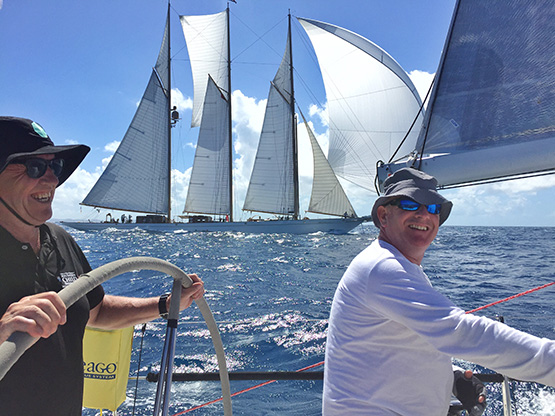
The 215–foot 'Adix' pictured to leeward of HYC helm Colm 'Bermo' Bermingham and Frank 'Buller' Dillon on Southern Child
It was clear from the beginning that Frank 'Buller' Dillon was the most chilled-out member of the team and even when confronted with the news that the ice had run out at the welcoming party in Antigua Yacht Club, he rationalised that "the rum was purer!" Whilst still somewhat of a mystery in terms of its origin, Frank's nickname ('Buller') belies his relaxed demeanour in these latitudes and he was one of the many Irish sailors who enjoyed the warm greeting on the welcome night in AYC, including a special 'Cead mile failte' (Irish for 'one hundred thousand welcomes') given to them by RORC Commodore Micheal Boyd from the outdoor stage and to a tumoultous cheer.
With the exception of owner Lucy Reynolds, all of the crew of Southern Child are members of Howth Yacht Club in Ireland and form part of a 2-boat team with 'Bam', the other Howth entry a division below in Class 3.
Southern Child was steered past St Kitts and St Nevis late on Monday night by crew member Colm 'Bermo' Bermingham under the brilliant light of a Caribbean full moon, completing the first day of racing and within 500 metres of almost all boats in IRC Class 2. The night time temperature barely dropped to 26 degrees Celcius and with an 18-knot wind pushing us through schools of small dolphins in the very warm moonlit Eastern Caribbean Sea, might it be possible that it might continue like this...?
Irish Sailors Up For It In RORC Caribbean 600
For those reared in the simple certainties of the course in the offshore classics like the Rolex Fastnet Race and the even more clearly defined Volvo Round Ireland Race, the multi-island RORC Caribbean 600 which starts tomorrow (Monday) morning at Antigua is a strange beast writes W M Nixon.
Set against the straight-line austerity of other long-established classics such as the Newport-Bermuda and the Rolex Sydney-Hobart, its weaving course makes it seem almost fussy. But in a typical February in the Northern Hemisphere, people will happily race round as many islands as are required to make the magic 600 miles total. Just so long as it’s in those marvellous Caribbean sailing and climatic conditions which contrast so totally with what many other areas of the Northern Hemisphere are experiencing in this dank dark cold month.

It’s a busy course – with so many islands to be ticked off, navigators could usefully employ the services of a continuity director…
Eleven islands are required to act as race marks in order to put sufficient mileage in the course. But with 77 boats – many of them noted superstars – tuned up and ready to go, it’s clear that the huge variety of legs both long and short which have to be sailed is no deterrent, and Irish interest is high both in terms of participation, and in the presence of international contenders expected for the Volvo Round Ireland Race in June.
Then too we’ve a certain proprietorial interest. The Caribbean 600 having been inaugurated as recently as 2009, it’s a modern classic. And the fact that on its first staging, it was won overall by Adrian Lee’s Cookson 50 Lee Overlay Partners from Dun Laoghaire, makes it extra special. For in her previous life as Ger O’Rourke’s Chieftain, the Lee ship had been overall winner in the Rolex Fastnet Race 2007, providing the rare if not unique situation that the same Irish boat won two classics in the space of just 18 months.
Six years later, the ever-green Cookson 50 is such a good all-rounder that she’s still very much in the hunt, and Lee Overlay Partners is in the listings for tomorrow’s start, the smallest boat in the six strong canting-keel division which includes such giants as Jim and Kristy Hinze Clark’s mega-powerful hundred footer Comanche.
We’ve interest throughout the race, as in addition to Lee Overlay Partners, the fleet includes two Howth Yacht Club crews. Howth sailors with the likes of Kieran Jameson on the strength have already got involved in past seasons in the Rolex Middle Sea Race with a Performance Yacht Charter’s First 40, and now with two of PWC’s boats of this proven marque on the other side of the Atlantic, there with PYC’s Lucy Johnson on Southern Child are Howth men raring to go Caribbean island-rounding. Much of the Howth team assembled by Darren Wright for the 2014 Rolex Middle Sea Race are re-joining the same boat, Southern Child, and their lineup incudes Kieran Jameson, Frank Dillon, Rick de Neve, Jonny White, Colm Bermingham, while new talent in the form of Michael Wright, recently-retired HYC Commodore Brian Turvey, and young Howth K25 squad member Luke Malcolm are also on the strength.
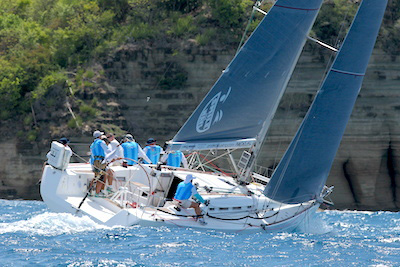
One of the two Howth crews will be racing the First 40 Southern Child, which they’ve already campaigned in the Rolex Middle Sea Race
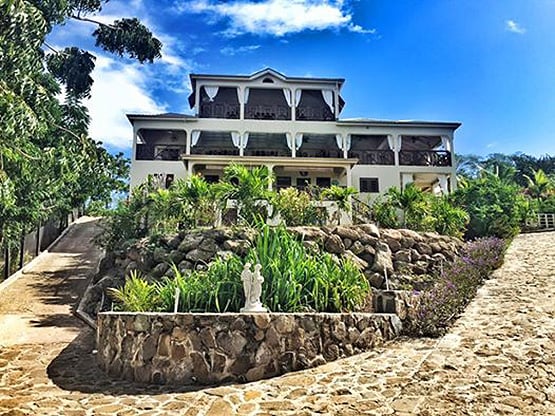
Howth Yacht Club Headquarters for the RORC 600: Villa Touloulou
Up against them to provide a spot of in-club competition is HYC’s Conor Fogerty who is doing an Atlantic circuit as a mix of racing and cruising with his new Sunfast 3600 Bam, a boat which might have been designed with RORC Caribbean 600 enjoyment in mind. Bam’s racing crew coming out from home include Simon Knowles, Daragh Heagney, Paddy Gregory, Roger Smith and Anthony Doyle. After Bam sister-ship Red Shift’s success in last year’s race, Conor Fogerty has great hopes for his stylish boats showing once tomorrow has seen the start – usually a very challenging business in itself – get cleanly away.
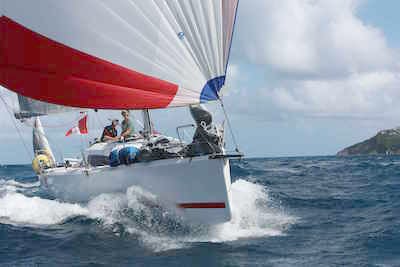
Conor Fogerty’s Sunfast 36 Bam from Howth is doing the RORC Caribbean 600 as part of an Atlantic odyysey
Ireland’s own RORC Commodore Michael Boyd of the RIYC, who won the Gull Salver for best-placed Irish boat in last year’s Fastnet Race with the Grand Soleil 43 Quokka 8, is helping to pass the time while waiting for delivery of his new JPK 10.80 by racing the Caribbean as navigator on Andy McIrvine’s Grand Soleil 46 Bella Donna.
As for pointers towards the Volvo Round Ireland Race in June, the two MOD 70 trimarans already signed up for it, Lloyd Thornburg’s Phaedo 3 and Concise 10 (Tony Lawson & Ned Collier Waefield) are both g0ing for the Caribbean 600.

Lloyd Thornburg’s MOD 70 Phaedo 3 is one of two sister-ships entered for the Volvo Round Ireland Race 2016 which are also doing the Caribbean 600, the other being Concise 10.
In fact it’s a very eclectic fleet, as Eric de Turckheim’s noted Commodore’s Cup contender of 2014, Teasing Machine from France, has somehow got herself to the Caribbean after being far away to cut a successful swathe through the recent Rolex Sydney-Hobart Race. And up towards the top of the fleet, the 72ft mini-maxi Momo, which was best of the bigger boats in last summer’s Fastnet, find herself up against Hap Fauth’s similarly-sized superstar Bella Mente, which had to scratch from the 2015 Fastnet Race for personal reasons after a blisteringly successful Cowes Week, but is now set to go in a race in which she is the defending champion.

Back to the fray. Having been forced to scratch from the Rolex Fastnet 2015 in which she was a favourite, Hap Fauth’s 72ft mini-maxi Bella Mente is very much in the hunt in tomorrow morning’s RORC Caribbean 600, in which she is defending champion.
The 72ft mini-maxis seem to be the favoured size of boat o the most recent peformances, as Nik Zennstrom’s Ran won in 2012, George Sakellaris’s Shockwave won in 2014, and Bella Mente won in 2015. But the evergreen Cookson 50 is a good steady bet, with Lee Overlay Partners; win in 2009, and Ron O’Hanley’s with Privateer in 2013.
The RORC Caribbean 600 starting process gets under way at 1030hrs local time tomorrow morning off Antigua, and there are going to be 77 very busy crews having more than a few dry-mouth moments before they get clear away around this island’s beautiful east coast.
Irish Cruising Comes Centre Stage In Howth Yacht Club
With last night’s Irish Cruising Club Annual General Meeting & Prize-Giving hosted at Howth Yacht Club, and this morning’s day-long ISA Cruising Conference at the same venue, centre stage has been taken by the silent majority – the large but distinctly reticent segment of the sailing population which emphatically does not have racing as its primary interest afloat. W M Nixon takes us on a guided tour.
The great Leif Eriksson would approve of some of the more adventurous members of the Irish Cruising Club. They seem to be obsessed with sailing to Greenland and cruising along its coast. And it was the doughty Viking’s father Erik Thorvaldsson (aka Erik the Red) who first told his fellow Icelanders that he’d given the name of Greenland to the enormous island he’d discovered far to the west of Iceland. He did so because he claimed much of it was so lush and fertile, with huge potential for rural and coastal development, that no other name would do.
Leif then followed in the family tradition of going completely over the top in naming newly-discovered real estate. He went even further west and discovered a foggy cold part of the American mainland which he promptly named Vinland, as he claimed the area was just one potential classic wine chateau after another, and hadn’t he brought back the vines to prove it?
In time, Erik’s enthusiasm for Greenland was seen as an early property scam. For no sooner had the Icelanders established a little settlement there around 1000 AD than a period of Arctic cooling began to set in, and by the mid-1300s there’d been a serious deterioration of the climate. What had been a Scandinavian population of maybe five thousands at its peak faded away, and gradually the Inuit people – originally from the American mainland – moved south from their first beachheads established to the northwest around 1200 AD. They proved more successful at adapting to what had become a Little Ice Age, while no Vikings were left.
Now we’re in the era of global warming, and there’s no doubt that Greenland is more accessible. But for those of us who think that cruising should be a matter of making yourself as comfortable as possible while your boats sails briskly across the sea in a temperate climate or perhaps even warmer for preference, the notion of devoting a summer to sailing to Greenland and taking on the challenge of its rugged iron coast, with ice everywhere, still takes a bit of getting used to.
Yet in recent years the Irish boats seem to have been tripping over each other up there. And for some true aficionados, the lure of the icy regions was in place long before the effects of global warming were visibly making it more accessible.
Peter Killen of Malahide, Commodore of the Irish Cruising Club, is a flag officer who leads by example. It was all of twenty years ago that he was first in Greenland with his Sigma 36 Black Pepper, and truly there was a lot of ice about. The weather was also dreadful, while Ireland was enjoying the best summer in years.

Peter Killen’s Sigma 36 Black Pepper in local ice at the quay inside Cape Farewell in Greenland, August 1995

ICC Commodore Peter Killen’s current boat is Pure Magic, an Amel Super Maramu seen here providing the backdrop for a fine penguin in Antarctica, December 2004.
More recently, he and his crew of longterm shipmates have been covering thousands of sea miles in the Amel Super Maramu 54 Pure Magic, among other ventures having a look at lots more ice down Antarctic way to see how it compares with the Arctic. With all their wanderings, by the end of the 2014 season Pure Magic was laid up for the winter in eastern Canada in Nova Scotia. So of course in order to get back to Ireland through 2015, the only way was with a long diversion up the west coast of Greenland. And the weather was grand, while Ireland definitely wasn’t enjoying the best summer in years.
The Pure Magic team certainly believe in enjoying their cruising, however rugged the terrain. If the Greenland Tourist Board are looking for a marketing manager, they could do no better than sign up the skipper of Pure Magic for the job. His entertaining log about cruising the region – featured in the usual impressive ICC Annual edited for the fourth time by Ed Wheeler – makes West Greenland seem a fun place with heaps of hospitality and friendly folk from one end to the other.

If ice is your thing, then this is the place to be – Peter Killen’s Pure Magic off the west Greenland coast, summer 2015.
But then Peter Killen is not as other men. I don’t mean he is some sort of alien being from the planet Zog. Or at least he isn’t so far as I know. But the fact is, he just doesn’t seem to feel the cold. I sailed with him on a raw Autumn day some years ago, and while the rest of us were piling on the layers, our skipper was as happy as Larry in a short-sleeved shirt.
I’d been thinking my memory had exaggerated this immunity to cold. But there sure enough in the latest ICC Annual is a photo of the crew of Pure Magic enjoying a visit to the little Katersugaasivik Museum in Nuuk, and the bould skipper is in what could well be the same skimpy outfit he was wearing when we sailed together all those years ago. As for the rest of the group, only tough nut Hugh Barry isn’t wearing a jacket of some sort – even Aqqala the Museum curator is wearing one.
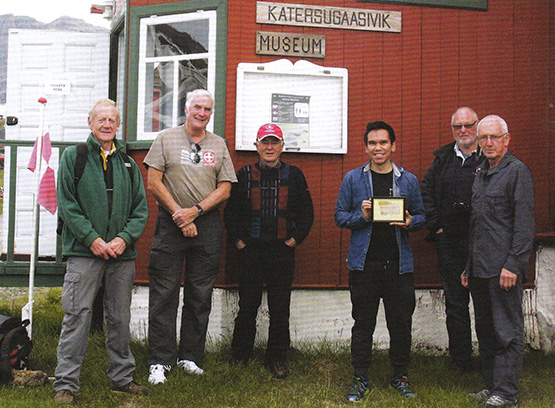
Some folk feel the cold more than others – Pure Magic’s crew absorbing local culture in Greenland are (left to right) Mike Alexander, Peter Killen, Hugh Barry, Aqqalu the museum curator, Robert Barker, and Joe Phelan
Having a skipper with this immunity to cold proved to be a Godsend before they left Greenland waters, when Pure Magic picked up a fishing net in her prop while motoring in a calm. Peter Killen has carried a wetsuit for emergencies for years, and finally it was used. He hauled it on, plunged in with breathing gear in action, and had the foul-up cleared in twenty minutes. Other skipper and Commodores please note……
The adjudicator for the 2015 logs was Hilary Keatinge, who has one of those choice-of-gender names which might confuse, so it’s good news to reveal that after 85 years, the ICC has had its first woman adjudicator. No better one for the job, man or woman. Before marrying the late Bill Keatinge, she was Hilary Roche, daughter of Terry Roche of Dun Laoghaire who cruised the entire coastline of Europe in a twenty year odyssey of successive summers, and his daughter has proven herself a formidable cruising person, a noted narrator of cruising experiences, and a successful writer of cruising guides and histories.
Nevertheless even she admitted last night that once all the material has arrived on the adjudicator’s screen, she finally appreciated the enormity of the task at hand, for the Irish Cruising Club just seems to go from strength to strength. Yet although it’s a club which limits itself to 550 members as anything beyond that would result in administrative overload and the lowering of standards, it ensures that the experience of its members benefit the entire sailing community through its regularly up-dated sailing directions for the entire coast of Ireland. And there’s overlap with the wider membership of the Cruising Association of Ireland, which will add extra talent to the expert lineup providing a host of information and guidance at today’s ISA Cruising Conference.
But that’s this morning’s work. Meanwhile last night’s dispensation of the silverware – some of which dates back to 1931 – revealed an extraordinarily active membership. And while they did have those hardy souls who ventured into icy regions, there were many others who went to places where the only ice within thousands of miles was in the nearest fridge, and instead of bare rocky mountains they cruised lush green coasts.
Nevertheless the ice men have it in terms of some of the top awards, as Hilary Keatinge has given the Atlantic Trophy for the best cruise with a passage of more than a thousand miles to the 4194 mile cruise of Peter Killen’s Pure Magic from Halifax to Nova Scotia to Howth, with those many diversions on the way, while the Strangford Cup for an alternative best cruise goes to Paddy Barry, who set forth from Poolbeg in the heart of Dublin Port, and by the time he’d returned he’d completed his “North Atlantic Crescent”, first to the Faeroes, then Iceland to port, then across the Denmark Strait to southeast Greenland for detailed cruising and mountaineering, then eventually towards Ireland but leaving Iceland to port, so they circumnavigated it in the midst of greater enterprises.
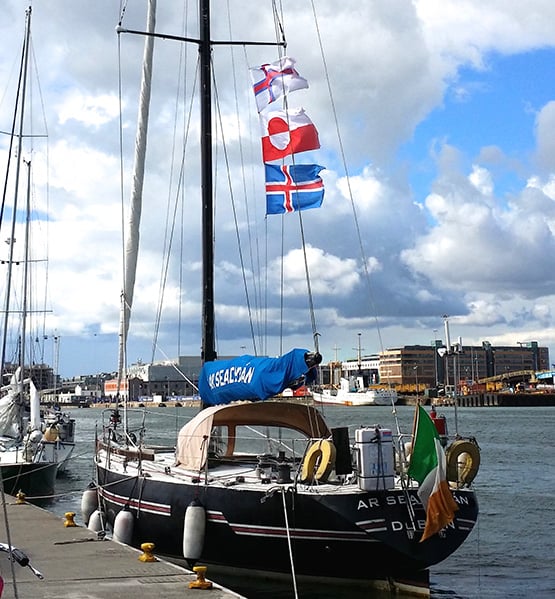
You collect very few courtesy ensigns in the frozen north. Back at Poolbeg in Dublin after her “North Atlantic Crescent” round Iceland and on to Greenland, Paddy Barry’s Ar Seachran sports the flags of the Faroes, Iceland and Greenland. Ar Seachran is a 1979 alloy-built Frers 45. Photo: Tony Brown
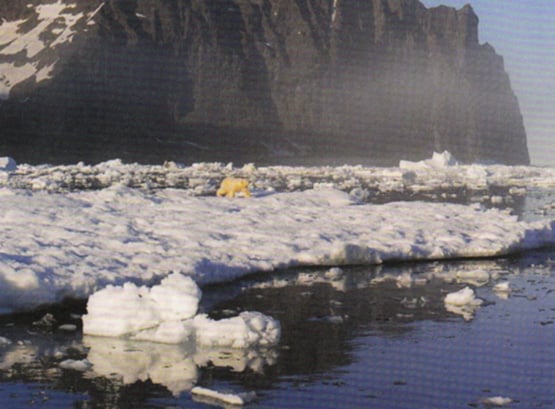
“Definitely the Arctic”. A polar bear spotted from Ar Seachran. Photo: Ronan O Caoimh
Paddy Barry started his epic ocean voyaging many years ago with the Galway Hooker St Patrick, but his cruising boat these days is very different, a classic Frers 45 offshore racer of 1979 vintage. Probably the last thing the Frers team were thinking when they turned out a whole range of these gorgeous performance boats thirty-five years ago was that their aluminium hulls would prove ideal for getting quickly to icy regions, and then coping with sea ice of all shapes and ices once they got there. But not only does Paddy Barry’s Ar Seacrhran do it with aplomb, so too does Jamie Young’s slightly larger sister, the Frers 49 Killary Flyer (ex Hesperia ex Noryema XI) from Connacht, whose later adventures in West Greenland featured recently in a TG4 documentary.
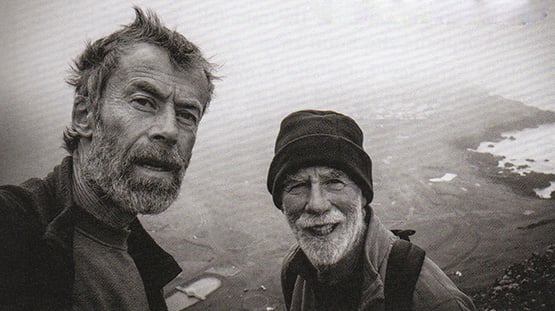
“A grand soft day in Iceland”. Harry Connolly and Paddy Barry setting out to take on mountains in Iceland during their award-winning cruise to Greenland. Photo: Harry Connolly
Pure Magic and Ar Seachran are hefty big boats, but the other ICC voyager rewarded last night by Hilary Keatinge for getting to Arctic waters did his cruise in the Lady Kate, a boat so ordinary you’d scarcely notice her were it not for the fact that she’s kept in exceptionally good trim.
Drive along in summer past the inner harbour at Dungarvan in West Waterford at low water, and you’ll inevitably be distracted by the number of locally-based bilge-keelers sitting serenely upright (more or less) on that famous Dungarvan mud. There amongst them might be the Moody 31 Lady Kate, for Dungarvan is her home port.
But she was away for quite a while last year, as Donal Walsh took her on an extraordinary cruise to the Arctic, going west of the British mainland then on via Orkney and Shetland to Norway whose coast goes on for ever until you reach the Artic Circle where the doughty Donal had a swim, as one does, and looked at a glacier or too, and then sailed home but this this time leaving the British mainland to starboard. A fabulous 3,500 mile eleven week cruise, he very deservedly was awarded the Fingal Cup for a venture the adjudicator reckons to be extra special – as she puts it, “you feel you’re part of the crew, though I don’t think I’d have done the Arctic Circle swim.”
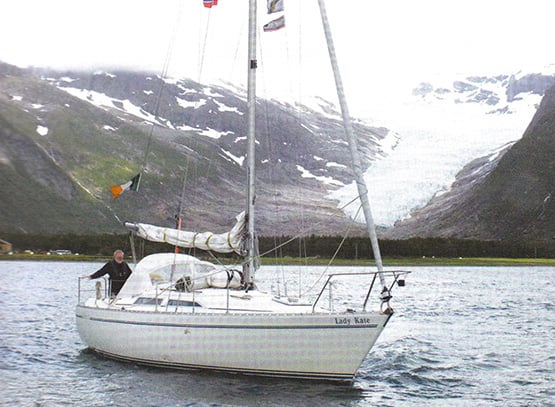
A long way from Dungarvan. Lady Kate with Donal Walsh off the Svartsen Glacier in northern Norway
Indeed, in taking an overview of the placings of the awards, you can reasonable conclude that the adjudicator reckons any civilized person can have enough of ice cruising, as she gives the ICC’s premier trophy, the Faulkner Cup, to a classic Atlantic triangle cruise to the Azores made from Dun Laoghaire by Alan Rountree with his van de Sadt-designed Legend 34 Tallulah, a boat of 1987 vintage which he completed himself (to a very high standard) from a hull made in Dublin by BJ Marine.
Tallulah looks as immaculate as ever, as we all saw at the Cruising Association of Ireland rally in Dublin’s River Liffey in September. And this is something of a special year for Alan Rountree, as completely independently of the Faulkner Cup award, the East Coast ICC members awarded their own area trophy, the Donegan Cup for longterm achievement, to Tallulah’s skipper. As one of those involved in the decision put it, basically he got the Donegan Trophy “for being Alan Rountree – what more can be said?”
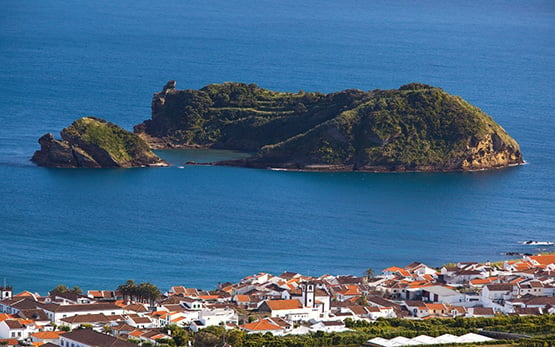
The essence of the Azores. Red roofs maybe, but not an iceberg in sight, and the green is even greener than Ireland. Alan Rountree’s succesful return cruise to the Azores has been awarded the ICC’s premier trophy, the Faulkner Cup.

Tallulah at the CAI Rally in the Liffey last Setpember. She looks as good today as when Alan Rountree completed her from a bare hull nearly thirty years ago. Photo: W M Nixon
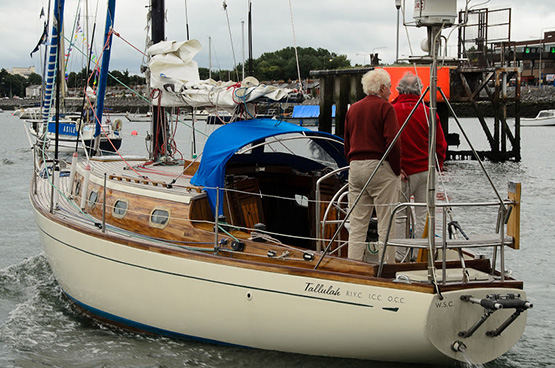
A boat to get you there – and back again. Tallulah takes her departure from the CAI Rally in Dublin. Photo: Aidan Coughlan
Well, it can be said that his Azores cruise was quietly courageous, for although the weather was fine in the islands, the nearer he got to Ireland the more unsettled it became, and he sailed with the recollection of Tallulah being rolled through 360 degrees as she crossed the Continental Shelf in a storm in 1991. But he simply plodded on through calm and storm, the job was done, and Tallulah is the latest recipient of a trophy which embodies the history of modern Irish cruising.
There were many other awards distributed last night, and for those who think that the ICC is all about enormous expensively-equipped boats, let it be recorded that the Marie Trophy for a best cruise in a boat under 30ft long went to Conor O’Byrne of Galway who sailed to the Hebrides with his Sadler 26 Calico Jack, while the Fortnight Cup was taken by a 32-footer, Harry Whelehan’s Jeanneau Sun Odyssey 32 for a fascinating cruise in detail round the Irish Sea, an area in which, the further east you get to coastlines known to very few Irish cruising men, then the bigger the tides become with very demanding challenges in the pilotage stales.
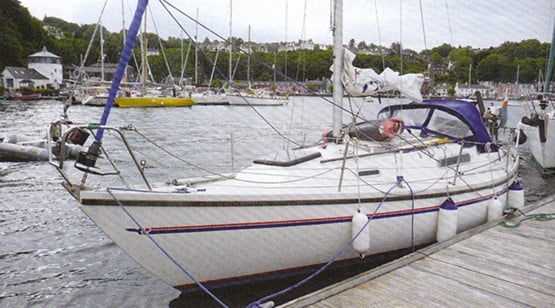
The smallest boat to be awarded a trophy at last night's Irish Cruising Club prize-giving was Conor O’Byrne’s Sadler 26 Calico Jack, seen here in Tobermory during her cruise from Connacht to the Hebrides
As for “expensively equipped”, the Rockabill Trophy for seamanship went to Paul Cooper, former Commodore of Clontarf Yacht & Boat Club and an ICC member for 32 years, who solved a series of very threatening problems with guts and ingenuity aboard someone else’s Spray replica during a 1500 mile voyage in the Caribbean, with very major problems being skillfully solved, as the judge observed, “without a cross word being spoken”.
Not surprisingly in view of the weather Ireland experienced for much of the season, there were no contenders for the Round Ireland cruise trophy, though I suppose you could argue that the return of Pure Magic meant the completion of a round Ireland venture, even if in this case the Emerald Isle becomes no more than a mark of the course.
In fact, with the unsettled weather conditions of recent summers in Ireland , there’s now quite a substantial group of ICC boats based out in Galicia in northwest Spain, where the mood of the coast and the weather “is like Ireland only better”. The ICC Annual gives us a glimpse of the activities of these exiles, and one of the most interesting photos in it is provided by Peter Haden of Ballyvaughan in County Clare, whose 36ft Westerly Seahawk Papageno has been based among the Galician rias for many years now.
Down there, the Irish cruising colony can even do a spot of racing provided it’s against interesting local tradtional boats, and Peter’s photo is of Dermod Lovett of Cork going flat out in his classic Salar 40 Lonehort against one of the local Dorna Xeiteras, which we’re told is the Galician equivalent of a Galway Bay gleoiteog. Whatever, neither boat in the photo is giving an inch.
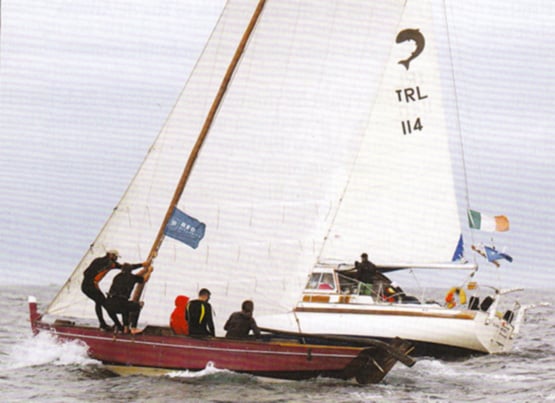
So who never races? Dermod Lovett ICC in competition with his Salar 40 Lonehort against a local traditional Dorna Xeiteira among the rias of northwest Spain. Photo: Peter Haden
Hilary Keatinge’s adjudication is a delight to read in itself, and last night after just about every sailing centre in Ireland was honoured with an ICC award for one of its locally-based members, naturally the crews leapt to the mainbrace and great was the splicing thereof.
But it’s back to porridge this morning in HYC and the serious work of the ISA Cruising Conference, where the range of topics is clearly of great interest, for the Conference was booked out within a very short time of being highlighted on the Afloat.ie website.
It’s during it that we’ll hear more about that intriguing little anchorage which provides our header photo, for although it could well be somewhere on the Algarve in Portugal, or even in the Ionian islands in Greece were it not for the evidence of tide, it is in fact on the Copper Coast of south Waterford, between Dungarvan and Dunmore East, and it’s known as Blind Harbour.
It’s a charming place if you’ve very settled weather, but it’s so small that you’d probably need to moor bow and stern if you were thinking to overnight, but that’s not really recommended anyway. Norman Kean, Editor of the Irish Cruising Club Sailing Directions, had heard about this intriguing little spot from Donal Walsh of Dungarvan (he who has just been awarded the Fingal Cup), and being Norman Kean, he and Geraldine just had to go and experience it for themselves. But it has taken three attempts to have the right conditions as they were sailing by, and it happened in 2015 in a very brief period of settled weather as they headed past in their recently-acquired Warrior 40 Coire Uisge, which has become the new flagship of the ICC’s informal survey flotilla.

The secret cove is to be found on Waterford’s Copper Coast, midway between Dungarvan and Dunmore East. Courtesy ICC
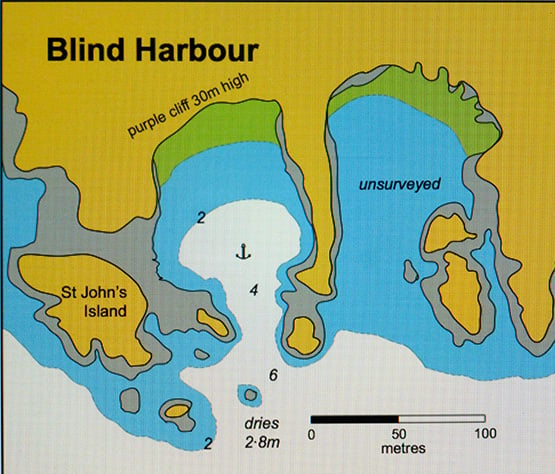
The newly-surveyed Blind Harbour on the Waterford coast as it appears in the latest edition of the ICC’s South & West Coasts Sailing Directions published this month. Courtesy ICC.
They found they’d to eye-ball their way in to this particular Blind Harbour (there are others so-named around the Irish coast) using the echo sounder, as any reliance on electronic chart assistance would have had them on the nearest part of County Waterford, albeit by only a matter of feet. With a similar exercise a couple of years ago, they found that the same thing was the case at the Joyce Sound Pass inside Slyne head in Connemara – rely in the chart plotter, and you’re making the pilotage into “impactive navigation”.
The message is that some parts of charts are still relying on surveys from a very long time ago, and locations of hyper-narrow channels may be a few metres away from where they actually are. On the other hand, electronic anomalies may arise. Whatever the reason, I know that a couple of years ago, in testing the ship’s gallant little chart plotter we headed for the tricky-enough Gillet passage inside the South Briggs at the south side of the entrance to Belfast Lough, and found that it indicated the rocks as shown were a tiny bit further north than we were seeing, which could have caused a but of a bump if we’d continued on our electronic way.
Electronic charts are only one of many topics which will be covered today. We hope to bring a full report next Saturday, for the participants will in turn require a day or two to digest their findings.
Howth Yacht Club Calls On Members To Push TDs On Harbour Dredging
#HYC - Howth Yacht Club has posted a draft letter for all club members and harbour users to send to their public representatives highlighting the urgent need to dredge Howth Harbour.
As previously reported on Afloat.ie, levels of silt build-up in the North Co Dublin harbour have accumulated to around 1.5 metres, rendering low-water spring-tide launches impossible.
The Harbour Users Action Group claims that various Governments since the 1980s have passed the buck for responsibility.
As such, the issue should be a priority among Howth voters heading into the General Election later this month.
In other HYC news, the club will host the ISA Cruising Conference on 20 February (more details HERE) a week before the club's race management team attends the ISA Race Officials Conference the at the Green Isle Hotel on 28 February.
The club is also hosting a prizegiving dinner for all Class 3 racing teams tomorrow evening Friday 12 February (contact the office for reservations) and another dinner next month in honour of the club's first commodore WH Boyd on Saturday 12 March, with a talk by Brian Turvey and Afloat.ie's own WM Nixon.
Howth Yacht Club Teams Set Sail for RORC's Caribbean 600
The challenge of a tough and competitive offshore race in the warm and idyllic racing conditions of the Caribbean has been taken up by two teams from Howth Yacht Club that will travel to Antigua to take part in the Royal Ocean Racing Club's 'Caribbean 600'. The 2016 race will see 66 entries start this 600-mile long offshore on the 22nd February which, due to the strong 20 knot trade winds and challenging navigation around 11 islands, is quickly becoming a classic in the RORC's calendar.
Darren Wright has put together an experienced offshore team that has chartered the First 40 Southern Child for the race. The team is made up of HYC members that raced the same boat in the 2014 Rolex Middle Sea Race, including Kieran Jameson, Frank Dillon, Rick De Neve, Jonny White, Colm Bermingham as well as owner Lucy Reynolds. Darren has added further strength to this campaign with the inclusion of his brother Michael along with Howth K25 Squad member Luke Malcolm and HYC's former-Commodore Brian Turvey.
One of three First 40s entered in this 600-mile offshore race, Southern Child is likely to be competing in the competitive and closely-matched IRC 2 division, while Howth's other entry, Conor Fogarty's SunFast 3600 Bam is likely to compete in the IRC 3 division and will be one of the smallest boats racing amongst the 66-boat fleet. An eclectic team of experienced offshoreracers will join Conor, including Simon Knowles, Daragh Heagney, Paddy Gregory, Roger Smith and Anthony Doyle. Conor told us "'We would hope to follow on from the success that Red Shift (another Sunfast 3600) had last year and it would be great to win in IRC 3. There is another 3600 in our class One and Only, but she trailed us by nearly 2 days in the ARC, so we will have to wait and see if she's up to speed yet."
Bam is then off to the Gill Commodore's Cup and Heineken Regatta in St.Maarten, more of a 'leisurely' event for Conor and the team, as they don't expect their CSA rating to be great. (CSA is the Caribbean Racing Association's version of ECHO, so Bam's introduction to the fleet will mean that she's likely to carry an initial hefty rating.) Bam will be sailed back 2,200nm to the Azores by Conor (single handed) in preparation for the inaugural Solo Fastnet in July, where he will compete with seven other 3600's all sailing single-handed in this event for the first time. The boat is also entered into the 2-handed Volvo Round Ireland and the 2-handed ISORA season - it's going to be a busy year for Conor!
The Caribbean 600 continues to grow in prestige and has become a real jewel in the RORC's racing calendar. The Howth teams will also be jostling for overall IRC honours with the world’s best, as this year's Caribbean 600 has attracted an astounding array of the fastest and most competitive offshore racing yachts on the planet. Shipping straight to the Caribbean from the Rolex Sydney Hobart Race will be Comanche, Jim & Kristy Hinze Clark's American 100ft Supermaxi, which rightly claims to be the fastest monohull in the world for her 24-hour record run (2015 Transatlantic Race, 618.01 nm, averaging 25.75 knots).
Comanche races with as many as 29 crew, led by Kenny Read, who was on board George David's Rambler 100 to set the RORC Caribbean 600 course record in 2011 (40 hours 20 mins 02 secs). Given the right conditions, Comanche is very capable of breaking Rambler 100's record. Joining Comanche in IRC ‘canting keel division’, will be Ireland's third entry in the star studded 66 boat fleet - Adrian Lee's Cookson 50 Lee Overlay Partners. Adrian and his team are no slouches when it comes to offshore racing in warm waters, having broken the monohull speed record in the Dubai to Muscat Race in 2013 and also won the inaugural Caribbean 600 in 2009.
Other boats in that class include Bouwe Bekking's Dutch Volvo Ocean 65 Team Brunel and the magnificent Andrews 80 Donnybrook. This will be the first occasion that a Volvo Ocean One Design has taken part in the RORC Caribbean 600 and although undoubtedly slower than Comanche reaching in big breeze, Team Brunel does have the advantage of being highly manageable around the myriad of corners of the 11 islands on this course. The German canting keel Ker 56 Varuna VI has been shipped to the Caribbean to take part, making up a formidable trio of early entries for the IRC canting keel class and more yachts are expected to follow.
In 2015, the 70 foot trimaran Phaedo3 set the RORC Caribbean 600 multihull record in 33 hours, 35 minutes and 30 seconds and is back again following its completion of the RORC Transatlantic Race in November.
Phaedo3 will have hot competition for multihull ‘line honours’ with the MOD 70 Concise 10 and also the Nigel Irens 63 Paradox, which might struggle to keep up with the larger, lighter rivals, but Paradox has beaten both yachts under the MOCRA rating rule for the Rolex Fastnet Race and the Rolex Middle Sea Race.
This event will be the first 4-boat ‘offshore-showdown’ in the history of the Maxi 72 Class. Bella Mente lifted the RORC Caribbean 600 Trophy in 2015, having scored the best corrected time under IRC. Bella Mente will be joined by Jethou, Momo and Proteus. All four yachts are capable of blistering pace in trade wind conditions and a high speed match race will make for thrilling racing. Joining the four Maxi 72s will be more hot competition from Irving Laidlaw's Rolex Maxi Yacht Cup champion Highland Fling XI which has the waterline length and a planing hull, capable of taking on the Maxi 72s. Overall winner of the 2015 Transatlantic Race, the RP63 Lucky will revel in the fast conditions. TP52 Sorcha and Piet Vroon's Ker 51 Tonnerre 4 had an epic battle last time out and both will be back this year. Sorcha won last year's 600-mile match race with Tonnerre 4 and placed second overall.
The RORC Caribbean 600 has always attracted the majestic classic yachts that frequent the Caribbean and this year includes the the Alfred Mylne designed 65ft sloop, the Blue Peter which was built in England in 1930 and called the Blue Peter for luck, after the 'P' flag, which all Howth racing sailors will know is used as the preparatory signal before starting a race.
Following the release of the final list of entries, RORC Chief Executive Eddie Warden commented “The impressive number of high performance yachts is a superb endorsement for the RORC Caribbean 600. No offshore race in the world commands such a level of competition as we are seeing entered for the 2016 race. The unique 600 mile race course circumnavigates 11 islands, with guaranteed trade winds and creates spectacular sailing conditions and that is the big attraction."
RORC Commodore Michael Boyd will also be taking part in what will be his fifth race, navigating for RORC Admiral Andrew McIrvine on his Grand Soleil 46 Bella Donna. Micheal said of the race: “The RORC Caribbean 600 has beautiful weather and spectacular nature; whales and turtles are often sighted. At night conditions are warm with impressive meteor showers lighting up the sky. All of these elements make this a very special race. Everyone that takes part has their story from the race. Sailors come from all over the world with aspirations of winning their class, but win or lose, over the past seven editions of the race the competitors have told the RORC what a memorable experience it has been. I am sure those feelings will continue.”
The race starts and begins in Antigua and competitors expect fresh (but warm!) 15-22 knot easterly trades and big seas for the duration.
Jennifer Guinness 1937–2016
Jennifer Guinness was one of the most accomplished Irish amateur sailors of her generation. Her death at the age of 78, after a gallant battle with cancer, brings to an end an extraordinary life in which she was sometimes unwillingly in the full glare of public attention, yet she was never happier than with a few friends and family in an informal and private setting, whether at home or on a boat.
She was of a very maritime family - her father Colonel J B Hollwey was a leading figure in Dublin Bay sailing and also a noted pioneer in shipping, with his company Bell Lines being in the forefront of the international development of containerisation. Many of her earliest memories were of sailing from childhood, and she became experienced in every aspect of the sport, whether as helm or crew, inshore and offshore, racing and cruising.
With marriage to merchant banker John Guinness of Howth, she moved across Dublin Bay to live on the Baily and sail from Howth Harbour, and their shared love of sailing found fulfillment in the Folkboat Sharavoge, the McGruer 43ft yawl Sule Skerry, and then their final boat together - the Hood 50 ketch Deerhound. While she was a very supportive consort for John in his roles as Commodore of Howth Yacht Club and then Commodore of the Irish Cruising Club, for Jenny Guinness the real point of it all was to go sailing as much as possible, whether it was racing at every opportunity in a variety of boats – she was a noted helm in the International Dragon Class - or cruising extensively, with their range of places visited in detail taking in Spain to the south and the far reaches of Scandinavia to the north, all cruised in notably well-planned and competent ventures.
Her competitive instincts were also taken offshore – in 1975 she was a member of the Irish Admirals Cup team as crew on board Clayton Love Jnr’s Swan 44 Assiduous, and in 1986 she was a crewmember on Robin Knox-Johnston’s 60ft catamaran British Airways in a successful challenge for the Round Ireland Record.
She and John also occasionally raced Deerhound offshore, though the big ketch was essentially a cruising boat. But this didn’t restrain them from hard-driving of the ship, and a classic memory of Jenny Guinness is of a stormy cross-channel race from Howth to Holyhead in 1977. As was usual when the boat was racing, she was on the helm, but it was the crew’s decision to set the mizzen staysail.
In a fierce squall, the entire mizzen mast setup, complete with billowing staysail, collapsed around her. Yet not only was she miraculously unscathed, but she blithely continued steering, helming on from amidst the ruins of the rig while crisply telling her husband and the rest of the crew that as they had decided to put up the extra sail, it was their job to tidy up the resulting mess - she meanwhile had some serious sailing to do, as the wind was by now hitting gale force, they’d a race to finish, and the mainmast was still standing and working well. Having started the race as a ketch, Deerhound finished it as a sloop.

It’s a cold wet night in May 1986, but the big catamaran is on track to a new Round Ireland Record, the helmsman has the boat going sweetly, and in the tiny cabin Jenny Guinnness decides that the watch below need a little whiskey as a warmer, and Josh Hall and Robin Knox-Johnston agree. Photo: W M Nixon
For most of their life together, she and John lived in the characterful old family home of Ceanchor House overlooking Dublin Bay and the Wicklow Hills – it was a centre of informal and generous hospitality on an often international scale, frequently and boisterously filled with sailing friends from near and far. They were also raising a family, and while there had been extreme challenges such as her kidnapping in 1986, underneath her sometimes shy exterior she was one very tough person, and she emerged successfully, and if anything stronger than ever, from experiences which would have defeated a lesser individual.
Her most devastating test came in 1988, when John was tragically killed in a mountain-walking accident in Snowdonia. The gallantry of her response to this personal disaster was inspirational. In time, she was back afloat, and moved on from Deerhound to two boats which were very definitely an expression of Jenny Guinness’s view of sailing, as they were formidable performance cruisers, both called Alakush - the first a very speedy Humphreys-designed Sovereign 400, the second a handsome Sabre 426.
Sailing these fine boats, she continued her stylish progress across the sea in racing and cruising, supported by family and a loyal group of friends who relished the challenge of sailing with a determined skipper whose exceptional ability at the helm was well matched by her creative skill in the galley. Her zest in the sport was restricted only by the onset of arthritis in her latter years, which she found exasperating, but battled in typically doughty style.
She faced the final challenge of terminal cancer with the same gallantry. She was determined to see Christmas 2015 despite medical expectations to the contrary, and she did it in style for a “truly magical” Christmas in the midst of a large party of extended family and close friends, most of them shipmates too. This well-lived life has now come to an end, and our heartfelt condolences go to Jennifer Guinness’s husband Alex Booth, her family and her many friends.
WMN
Howth YC To Host Talk On The North Atlantic Crescent
#HowthYC - Ocean adventurer Paddy Barry will give a talk at Howth Yacht Club this Friday (22 January) on the North Atlantic Crescent, a voyage he undertook with friends from Ireland to Greenland via the Faroe Islands and Iceland.
All are welcome to the clubhouse for the evening of adventurous cruising tales hosted by the HYC Cruising Group. For more information contact the club via the website HERE.
As climber Gerry Galligan explains in his blog, Paddy Barry and his regular crew were planning a sailing-climbing trip to Iceland, East Greenland, then back to Iceland again on his boat Ar Seachrán.
Paddy’s trip was part of a wider journey of island-hopping from Ireland to Greenland and back by way of the Hebrides, Faroes and Iceland; re-tracing the likely voyages Irish monks such as St. Brendan made, centuries ago. This overall project was given a name, The North Atlantic Crescent Adventure 2015; our scope, one leg of it, was to sail to Greenland, attempt some climbs, ideally first ascents, of the coastal peaks of the Lemon mountain range, before sailing 240 miles down the coast to the village of Tasiilaq.
The seven were skipper Paddy, blacksmith and rifle-man Ronán Ó Caoimh, myself, and four old IMC hands: Frank Nugent, Harry Connolly, Peter Gargan and Paddy O’Brien. More from Galligan here.
IOM Model Yacht Series Gets Underway at Howth Yacht Club
Model Yacht Racers finally got a nice day yesterday, Sunday 10th January with a gentle breeze and a fresh but not too cold day in Howth YC for our first racing day of 2016 writes Gilbert Louis.
We had all the usual suspects of the Dublin fleet with Fergal, Des, Stephen, Jeff and I.
We completed 10 races after a bit of training and tuning together on the water.
Jeff came on top with his trusted reinforced Britpop design. Reliable, well-tuned and sailed well he was the man to beat!
Des was the most improved skipper with his homemade Alternative design. He was well up there winning one race but always on the money. Well done Des !
Fergal was back with his now older design Disco but with a new set of sails from New Zealand. And they look the bizneez too ;-) Great to see Fergal back on the water.
Gilbert was out trying a new deeper rudder and new set of sails on his trusted wooden Goth XP from Frank Russell and had a mix day with few handling mistakes. He had a certain liking for the weather mark he rounded a little too close a few times, so much so that he decided to ‘hug’ it for most of the last race while the others were battling for the last race of the day!
Stephen out with his V9, a Ian Vickers design who also had a mix day tasting line honours but missing the last 2 races due to some electrical glitches…
Despite each racing different designs, sails, and their own tuning the sailing was close with all 5 boats arriving close together. You make a mistake! Then you ‘pay cash’, the punishment is instant and with boats of similar performance it is hard to catch up so everyone has to be on top of their game.
We will be back in two weeks for the next round!


























